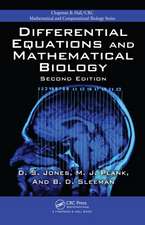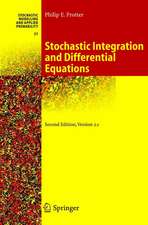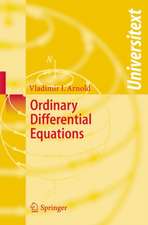The Navier-Stokes Problem in the 21st Century
Autor Pierre Gilles Lemarie-Rieusseten Limba Engleză Hardback – 8 dec 2023
“"This is a great book on the mathematical aspects of the fundamental equations of hydrodynamics, the incompressible Navier-Stokes equations. It covers many important topics and recent results and gives the reader a very good idea about where the theory stands at present.”—Vladimir Sverak, University of Minnesota
The complete resolution of the Navier–Stokes equation—one of the Clay Millennium Prize Problems—remains an important open challenge in partial differential equations (PDEs) research despite substantial studies on turbulence and three-dimensional fluids. The Navier–Stokes Problem in the 21st Century, Second Edition continues to provide a self-contained guide to the role of harmonic analysis in the PDEs of fluid mechanics, now revised to include fresh examples, theorems, results, and references that have become relevant since the first edition published in 2016.
| Toate formatele și edițiile | Preț | Express |
|---|---|---|
| Hardback (2) | 729.32 lei 6-8 săpt. | |
| CRC Press – 8 mar 2016 | 729.32 lei 6-8 săpt. | |
| CRC Press – 8 dec 2023 | 774.03 lei 6-8 săpt. |
Preț: 774.03 lei
Preț vechi: 850.58 lei
-9% Nou
Puncte Express: 1161
Preț estimativ în valută:
148.11€ • 155.05$ • 122.55£
148.11€ • 155.05$ • 122.55£
Carte tipărită la comandă
Livrare economică 05-19 aprilie
Preluare comenzi: 021 569.72.76
Specificații
ISBN-13: 9780367487263
ISBN-10: 0367487268
Pagini: 778
Dimensiuni: 178 x 254 x 41 mm
Greutate: 1.55 kg
Ediția:2nd edition
Editura: CRC Press
Colecția Chapman and Hall/CRC
ISBN-10: 0367487268
Pagini: 778
Dimensiuni: 178 x 254 x 41 mm
Greutate: 1.55 kg
Ediția:2nd edition
Editura: CRC Press
Colecția Chapman and Hall/CRC
Public țintă
Academic and PostgraduateCuprins
1. Presentation of the Clay Millennium Prizes. 1.1. Regularity of the three-dimensional fluid flows: a mathematical challenge for the 21st century. 1.2. The Clay Millennium Prizes. 1.3. The Clay Millennium Prize for the Navier-Stokes equations. 1.4. Boundaries and the Navier-Stokes Clay Millennium Problem. 2. The physical meaning of the Navier-Stokes equations. 2.1. Frames of references. 2.2. The convection theorem. 2.3. Conservation of mass. 2.4. Newton's second law. 2.5. Pressure. 2.6. Strain. 2.7. Stress. 2.8. The equations of hydrodynamics. 2.9. The Navier-Stokes equations. 2.10. Vorticity. 2.11. Boundary terms. 2.12. Blow-up. 2.13. Turbulence. 3. History of the equation. 3.1. Mechanics in the Scientific Revolution era. 3.2. Bernoulli's Hydrodymica. 3.3. D'Alembert. 3.4. Euler. 3.5. Laplacian physics. 3.6. Navier, Cauchy, Poisson, Saint-Venant, and Stokes. 3.7. Reynolds. 3.8. Oseen, Leray, Hopf, and Ladyzhenskaya. 3.9. Turbulence models. 4. Classical solutions. 4.1. The heat kernel. 4.2. The Poisson equation. 4.3. The Helmholtz decomposition. 4.4. The Stokes equation. 4.5. The Oseen tensor. 4.6. Classical solutions for the Navier-Stokes problem. 4.7. Maximal classical solutions and estimates in L∞ norms. 4.8. Small data. 4.9. Spatial asymptotics. 4.10. Spatial asymptotics for the vorticity. 4.11. Maximal classical solutions and estimates in L2 norms. 4.12. Intermediate conclusion. 5. A capacitary approach of the Navier-Stokes integral equations. 5.1. The integral Navier-Stokes problem. 5.2. Quadratic equations in Banach spaces. 5.3. A capacitary approach of quadratic integral equations. 5.4. Generalized Riesz potentials on spaces of homogeneous type. 5.5. Dominating functions for the Navier-Stokes integral equations. 5.6. Oseen's theorem and dominating functions. 5.7. Functional spaces and multipliers. 6. The differential and the integral Navier-Stokes equations. 6.1. Very weak solutions for the Navier-Stokes equations. 6.2. Heat equation. 6.3. The Leray projection operator. 6.4. Stokes equations. 6.5. Oseen equations. 6.6. Mild solutions for the Navier-Stokes equations. 6.7. Suitable solutions for the Navier-Stokes equations. 7. Mild solutions in Lebesgue or Sobolev spaces. 7.1. Kato's mild solutions. 7.2. Local solutions in the Hilbertian setting. 7.3. Global solutions in the Hilbertian setting. 7.4. Sobolev spaces. 7.5. A commutator estimate. 7.6. Lebesgue spaces. 7.7. Maximal functions. 7.8. Basic lemmas on real interpolation spaces. 7.9. Uniqueness of L3 solutions. 8. Mild solutions in Besov or Morrey spaces. 8.1. Morrey spaces. 8.2. Morrey spaces and maximal functions. 8.3. Uniqueness of Morrey solutions. 8.4. Besov spaces. 8.5. Regular Besov spaces. 8.6. Triebel-Lizorkin spaces. 8.7. Fourier transform and Navier-Stokes equations. 8.8. The cheap Navier-Stokes equation. 8.9. Plane waves. 9. The space BMO-1 and the Koch and Tataru theorem. 9.1. The Koch and Tataru theorem. 9.2. A variation on the Koch and Tataru theorem. 9.3. Q-spaces. 9.4. A special subclass of BMO-1. 9.5. Ill-posedness. 9.6. Further results on ill-posedness. 9.7. Large data for mild solutions. 9.8. Stability of global solutions. 9.9. Analyticity. 9.10 Small data. 10. Special examples of solutions. 10.1 Symmetries for the Navier-Stokes equations. 10.2 Two-and-a-half dimensional flows. 10.3 Axisymmetrical solutions. 10.4 Helical solutions. 10.5 Brandolese's symmetrical solutions. 10.6 Self-similar solutions. 10.7 Stationary solutions. 10.8 Landau's solutions of the Navier-Stokes equations. 10.9 Time-periodic solutions. 10.10 Beltrami flows. 11. Blow-up? 11.1. First criteria. 11.2. Blow-up for the cheap Navier-Stokes equation. 11.3. Serrin's criterion. 11.4. A remark on Serrin's criterion and Leray's criterion. 11.5. Some further generalizations of Serrin's criterion. 11.6. Vorticity. 11.7. Squirts. 11.8. Eigenvalues of the strain matrix. 12. Leray's weak solutions. 12.1. The Rellich lemma. 12.2. Leray's weak solutions. 12.3. Weak-strong uniqueness: the Prodi-Serrin criterion. 12.4. Weak-strong uniqueness and Morrey spaces on the product space R x R3. 12.5. Almost strong solutions. 12.6. Weak perturbations of mild solutions. 12.7. Non-uniqueness of weak solutions. 12.8. The inviscid limit. 13. Partial regularity results for weak solutions. 13.1. Interior regularity. 13.2. Serrin's theorem on interior regularity. 13.3. O'Leary's theorem on interior regularity. 13.4. Further results on parabolic Morrey spaces. 13.5. Hausdor_ measures. 13.6. Singular times. 13.7. The local energy inequality. 13.8. The Caffarelli-Kohn-Nirenberg theorem on partial regularity. 13.9. Proof of the Caffarelli-Kohn-Nirenberg criterion. 13.10. Parabolic Hausdorff dimension of the set of singular points. 13.11. On the role of the pressure in the Caffarelli, Kohn and Nirenberg regularity. theorem. 14. A theory of uniformly locally L2 solutions. 14.1. Uniformly locally square integrable solutions. 14.2. Local inequalities for local Leray solutions. 14.3. The Caffarelli, Kohn and Nirenberg ϵ-regularity criterion. 14.4. A weak-strong uniqueness result. 14.5. Global existence for local Leray solutions. 14.6. Weighted estimates. 14.7. A stability estimate. 14.8. Barker's theorem on weak-strong uniqueness. 14.9. Further results on global existence of suitable weak solutions. 15. The L3 theory of suitable solutions. 15.1. Local Leray solutions with an initial value in L3. 15.2. Blow up in finite time. 15.3. Backward uniqueness for local Leray solutions. 15.4. Seregin's theorem. 15.5. Further comments on Seregin's theorem. 15.6. Critical elements for the blow-up of the Cauchy problem in L3. 15.7. Known results on the Cauchy problem for the Navier-Stokes equations in presence of a force. 15.8. Local estimates for suitable solutions. 15.9. Uniqueness for suitable solutions. 15.10. A quantitative one-scale estimate for the Caffarelli-Kohn-Nirenberg regularity criterion. 15.11. The topological structure of the set of suitable solutions. 15.12. Escauriaza, Seregin and Sverak's theorem. 16. Self-similarity and the Leray-Schauder principle.16.1. The Leray-Schauder principle. 16.2. Steady-state solutions. 16.3. The Liouville problem for steady solutions. 16.4. Self-similarity. 16.5. Statement of Jia and Sverak's theorem. 16.6. The case of locally bounded initial data. 16.7. The case of rough data. 16.8. Non-existence of backward self-similar solutions. 16.9. Discretely self-similar solutions. 16.10. Time-periodic weak solutions. 17. α-models. 17.1. Global existence, uniqueness and convergence issues for approximated equations. 17.2. Leray's mollification and the Leray α-model. 17.3. The Navier-Stokes α-model. 17.4. The Clark-model. 17.5. The simplified Bardina model. 17.6. Reynolds tensor. 18. Other approximations of the Navier-Stokes equations. 18.1. Faedo-Galerkin approximations. 18.2. Frequency cut-off. 18.3. Hyperviscosity. 18.4. Ladyzhenskaya's model. 18.5. Damped Navier-Stokes equations. 19. Artificial compressibility. 19.1. Temam's model. 19.2. Visik and Fursikov's model. 19.3. Hyperbolic approximation. 20. Conclusion. 20.1. Energy inequalities. 20.2. Critical spaces for mild solutions. 20.3. Models for the (potential) blow-up. 20.4. The method of critical elements. 20.5. Some open questions. Notations and glossary.
Notă biografică
Pierre Gilles Lemarié-Rieusset is a professor at the University of Evry Val d’Essonne. Dr. Lemarié-Rieusset has constructed many widely used bases, such as the Meyer-Lemarié wavelet basis and the Battle-Lemarié spline wavelet basis. His current research focuses on the application of harmonic analysis to the study of nonlinear PDEs in fluid mechanics. He is the author or co-author of several books, including Recent Developments in the Navier-Stokes Problem.
Recenzii
Praise for the first edition
“The author is an outstanding expert in harmonic analysis who has made important contributions. The book contains rigorous proofs of a number of the latest results in the field. I strongly recommend the book to postgraduate students and researchers working on challenging problems of harmonic analysis and mathematical theory of Navier-Stokes equations."
—Gregory Seregin, St Hildas College, Oxford University
“"This is a great book on the mathematical aspects of the fundamental equations of hydrodynamics, the incompressible Navier-Stokes equations. It covers many important topics and recent results and gives the reader a very good idea about where the theory stands at present.”
—Vladimir Sverak, University of Minnesota
“The author is an outstanding expert in harmonic analysis who has made important contributions. The book contains rigorous proofs of a number of the latest results in the field. I strongly recommend the book to postgraduate students and researchers working on challenging problems of harmonic analysis and mathematical theory of Navier-Stokes equations."
—Gregory Seregin, St Hildas College, Oxford University
“"This is a great book on the mathematical aspects of the fundamental equations of hydrodynamics, the incompressible Navier-Stokes equations. It covers many important topics and recent results and gives the reader a very good idea about where the theory stands at present.”
—Vladimir Sverak, University of Minnesota
Descriere
This book provides a self-contained guide to the role of harmonic analysis in the PDEs of fluid mechanics, now revised to include fresh examples, theorems, results, and references that have become relevant since the first edition published in 2016.














